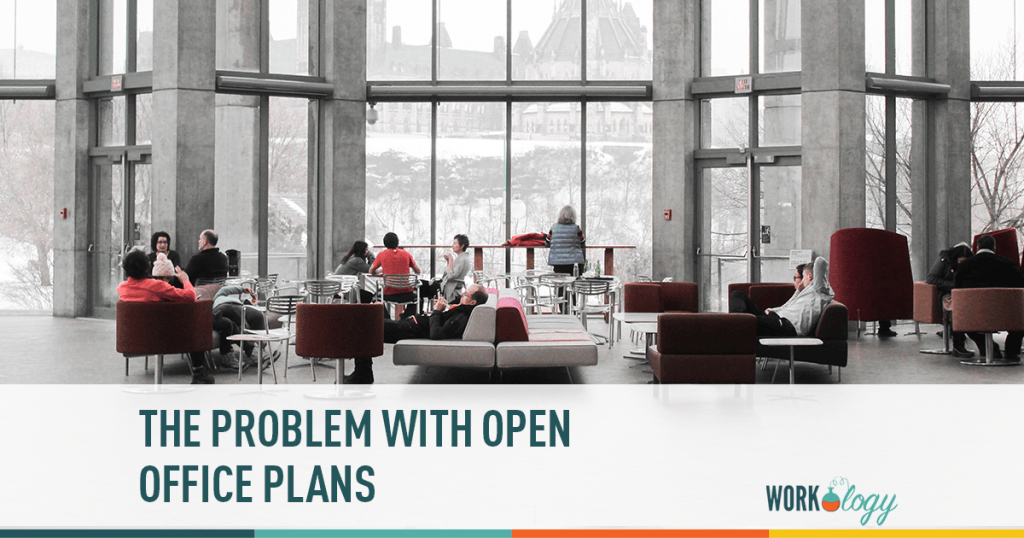Supporters of open office plans point to such arrangements as fostering teamwork and building camaraderie. The thought is that without walls, co-workers have easier access to share ideas with each other, which could lead to innovation. In reality, open office plans can be noisy and full of distractions. While an open office plan may be a nice visual for teamwork, I think it ultimately gets in the way of a productive work environment.
Noise, Distraction & Decreased Productivity
Open office plans originated in Hamburg, Germany in the 1950s as a way to improve communication.1 Despite the original intent, research has shown the open office plans may do more harm than good. In her article for The New Yorker, Maria Konnikova points to work done by organizational psychologist Matthew Davis in 2011. She writes, “He found that, though open offices often fostered a symbolic sense of organizational mission,…they were damaging to the workers’ attention spans, productivity, creative thinking and satisfaction.”
In an open office plan, noise, overheard conversations and constant activity are all distractions that employees must deal with. While such a set up may be beneficial in a job where the majority of time is spent in collaboration with others, many of us who work in office jobs have periods of time that require close concentration, which can be a challenge in a noisy and busy environment.
Konnikova also discusses studies that offices with walls create an environment where workers feel like they have some control over their work environment. She writes, “When workers couldn’t change the way that things look, adjust lighting and temperature, or choose how to conduct meetings, spirits plummeted.”
In my own HR experience, the most frequent complaints I dealt with from office workers had to do with noise level or comfort in shared office spaces. With so much time spent at work, it is important to have a workspace that is comfortable and conducive to concentration and high productivity. This all raises the question of whether or not open office plans are beneficial.
Fostering A Collaborative Environment
Collaboration is necessary to the success of most businesses. A study by design firm Gensler found that three out of four employees struggle to work effectively due to issues with being able to focus on work.2 Janet Pogue of Gensler appeared on KPCC’s AirTalk to discuss the study. She explains, “Many open-plan environments today are really designed to encourage collaboration, and those that only foster collaboration at the expense of focus are not as effective.”
For this reason, it is important for offices who want to implement an open-plan to consider how they will provide for the needs of employees that work best when they have a quiet space to focus when not collaborating with others.
Finding Quiet in an Open Office
I am an introvert and a highly sensitive person (HSP). This means my ideal work environment is a quiet one free from the normal distractions in an office. Any mention of working in an open-plan environment immediately gives me anxiety. In one of my HR jobs, space was at a premium and the company was still about a year away from moving to an office where we would have more office space. I liked my coworkers, but with all the talking on the phone, answering questions from employees and the traffic from the nearby front door, I often struggled with focus.
While not everyone is as sensitive to noise and distraction as I am, I think it is fair to say that many of us experience some level of frustration in a shared work environment. Whether it is to foster collaboration or because space will not allow for individual offices, it is important to remember this when you have an open office plan.
Consider setting aside some offices for employees who need to get away from the activity of the open area. This gives people a refuge when they need to close the door and work solo. My last supervisor would give us the option of sometimes working from home if we needed a few hours or a day to spend on projects that required a high level of concentration. If you do not have the space to set up closed-off workspaces, this may be a good option.
Remember to take the needs of your employees and the type of work you do into account when deciding if an open office is the right fit for your business. In order for collaboration to be effective, the right work environment needs to be established to meet your team’s needs.
References:
1 Konnikova, Maria. “The Open-Office Trap.” The New Yorker 7 January 2014. Online.
2 Yu, Pai En. “Do Open-Plan Offices Decrease Productivity?” 89.3 KPCC: AirTalk 8 July 2013. Online.








